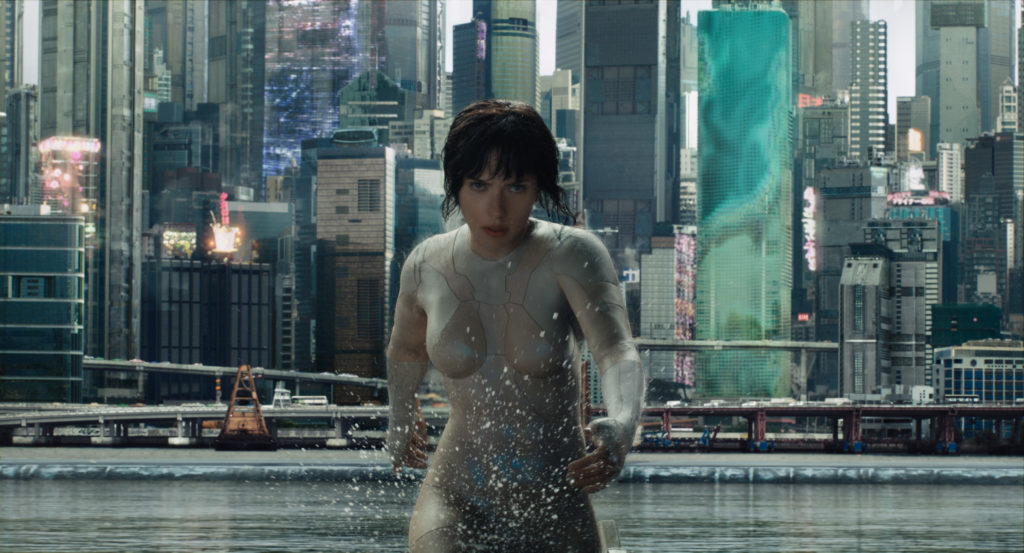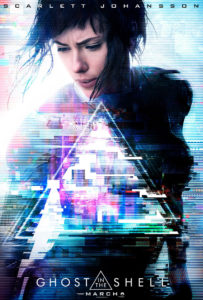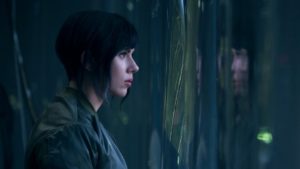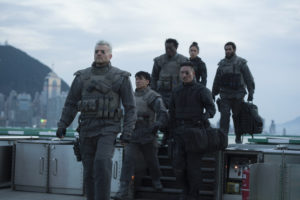“Ghost in the Shell” is a seinen manga series written and illustrated by Masamune Shirow. The Japanese comics have spawned a media franchise that includes animated films, books, video games and now an American film. Our J.P. reviews the Scarlett Johansson-led live-action, Hollywood adaptation.

Ghost in the Shell
Paramount Pictures
Directed by: Rupert Sanders
Produced by Avi Arad, Ari Arad, Steven Paul, Michael Costigan
Screenplay by Jamie Moss, William Wheeler, Ehren Kruger
Based on “Ghost in the Shell” by Masamune Shirow
Starring: Scarlett Johansson, Pilou Asbæk, Takeshi Kitano, Michael Pitt, Juliette Binoche
Studio Synopsis:
In the near future, Major (Scarlett Johansson) is the first of her kind: A human saved from a terrible crash, who is cyber-enhanced to be a perfect soldier devoted to stopping the world’s most dangerous criminals. When terrorism reaches a new level that includes the ability to hack into people’s minds and control them, Major is uniquely qualified to stop it. As she prepares to face a new enemy, Major discovers that she has been lied to: her life was not saved, it was stolen. She will stop at nothing to recover her past, find out who did this to her and stop them before they do it to others. Based on the internationally acclaimed Japanese Manga, “The Ghost in the Shell.”
J.P.’s Take:
 Provided you’re a diehard fan of anime, manga and gaming, you could then appreciate the imagery and tone of “Ghost in the Shell.” It paints a bleak picture of a future rampant with technology – frighteningly so – that robotically-enhanced humans fear being hacked. You heard me correctly — humans have integrated with machines in a way that computer viruses are our greatest nemesis. If you look around us in present times, our heads are bent downward, engrossed in our smart devices. We’re not far from simply plugging in and tuning out virtually; no longer engaging in the real world. That is the world the “Ghost in the Shell” lives in.
Provided you’re a diehard fan of anime, manga and gaming, you could then appreciate the imagery and tone of “Ghost in the Shell.” It paints a bleak picture of a future rampant with technology – frighteningly so – that robotically-enhanced humans fear being hacked. You heard me correctly — humans have integrated with machines in a way that computer viruses are our greatest nemesis. If you look around us in present times, our heads are bent downward, engrossed in our smart devices. We’re not far from simply plugging in and tuning out virtually; no longer engaging in the real world. That is the world the “Ghost in the Shell” lives in.
This live-action film version is not simply a copycat of director Mamoru Oshii’s animated features; it adheres to his archetypal works. Despite this being the Americanized interpretation, there is much Japanese imagery than meets the eye. What director Rupert Sanders presents is a style closely matching that of Japanese artist Masamune Shirow’s manga.
With its “Blade Runner- like character development, you are encompassed by Scarlett Johansson’s wondrous – if – Pinocchio like performance. All credit due to writers Jamie Moss, William Wheeler and Ehren Kruger for their spot on adaptation of both Oshii’s as well as Shirow’s definitive tales. There is a sense of yearning embedded in Johansson’s Major Mira Killian/Motoko Kusanagi, as she longs for her past life; not realizing what still lies within her cybernetic body is the human spirit. She is the first of her kind and after all she’s still haunted by her former existence. It’s all set against a backdrop of dystopic grunge and cyberpunk tropes that are consistent with Oshii’s films. The story is angsty drawing on technophobic hallmarks and paranoia surrounding technological advancement.

Speaking of the techo-verse, “Ghost in the Shell” sets the bar pretty high when it comes to production design. You’re not met with the basic definition of the “robot,” but instead glossy skinned cybernetic geishas that transform into multi-limbed killing machines. The Major’s cyborg body is also a wonder, as it houses the human brain with its “ghost.” From the neo-futuristic interiors filled with neon lighting to the sparse apartments, this is a Japan that is worlds apart from any other. The atmosphere is teeming with ominous environments, as gigantic holographic ads set atop towering buildings stalk the skyline like pixilated Gods. Some holograms even permeate through physical spaces and through the streets. Something called a spider-tank even shows up in the end battle scenes. All wonderfully realized in vivid IMAX 3D.
My only qualm would be that there is very little in the form of a true villain here. Hideo Kuze (Michael Pitt) is more of the anit-hero here; as he plays a cyber terrorist hell bent on bringing down Hanka Corp. Mr. Cutter (Peter Ferdinando) may serve as the film’s thinly veiled villain barking threats and ordering hits on people. However, his action never truly rises above simply ordering hits or threatening people. Even his take down was pretty anticlimactic.

Granted this specific “Ghost in the Shell” incarnation is not the most intricately spun narrative it could be. However, you have to consider the extensive manga and films franchises, the filmmakers are hard pressed to sum up in one film. Keep in mind they have to walk a fine line between fandom and new comer. I felt they chose one very pin pointed subject to weave from, which is The Major’s back story, in order introduce the character to unfamiliar viewers. Had they added any more to that, they would have probably lost their audience. Instead, they played it safe and reduced it to just the skeleton of what the anthology is all about. It does leave you with more questions as to how technology has either enhanced the human experience or what detrimental effects it also has. However, I feel that’s something they may explore in later possible sequels.
Yet in the end, I wasn’t totally disappointed with the results. I felt it carried just enough bleakness, with just enough humanness, with an equal amount of story to action. In fact, there were moments that reminded me of one of all time favorite sci-fi/noir films “Blade Runner.” “Ghost in the Shell” is actually one of the better adaptations of a manga/anime to movie I’ve seen in quite a while.
